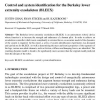Free Online Productivity Tools
i2Speak
i2Symbol
i2OCR
iTex2Img
iWeb2Print
iWeb2Shot
i2Type
iPdf2Split
iPdf2Merge
i2Bopomofo
i2Arabic
i2Style
i2Image
i2PDF
iLatex2Rtf
Sci2ools
AR
2006
2006
Control and system identification for the Berkeley lower extremity exoskeleton (BLEEX)
The Berkeley lower extremity exoskeleton (BLEEX) is an autonomous robotic device whose function is to increase the strength and endurance of a human pilot. In order to achieve an exoskeleton controller which reacts compliantly to external forces, an accurate model of the dynamics of the system is required. In this report, a series of system identification experiments was designed and carried out for BLEEX. As well as determining the mass and inertia properties of the segments of the legs, various non-ideal elements, such as friction, stiffness and damping forces, are identified. The resulting dynamic model is found to be significantly more accurate than the original model predicted from the designs of the robot.
AR 2006 | Autonomous Robotic Device | Berkeley Lower Extremity Exoskeleton | Exoskeleton Controller |
| Added | 10 Dec 2010 |
| Updated | 10 Dec 2010 |
| Type | Journal |
| Year | 2006 |
| Where | AR |
| Authors | Justin Ghan, Ryan Steger, Hami Kazerooni |
Comments (0)

